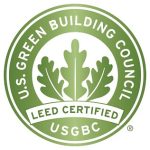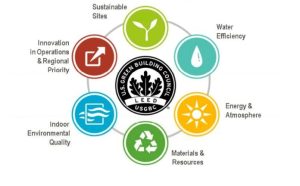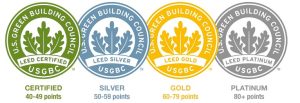
LEED & BREEAM CERTIFICATION ON CONSULTANCY
LEED & BREEAM CERTIFICATION ON CONSULTANCY
LEED and BREEAM Certification Consultancy
LEED (Leadership in Energy and Environmental Design) is a green building rating system developed by the United States Green Building Council (USGBC). As the most widely used green building rating system globally, LEED establishes benchmarks for sustainable design, construction, and operation at the building and community scale. It defines buildings that are healthier, more environmentally friendly, and more cost-effective to operate compared to traditional buildings.

History of the USGBC
Established over two decades ago with the goal of promoting environmentally friendly and healthy buildings, the USGBC was founded by Rick Fedrizzi, David Gottfried, and Mike Italiano. In April 1993, they convened the first USGBC founding meeting in the American Institute of Architects auditorium, bringing together approximately 60 representatives from various companies and a group of dedicated volunteers. Their mission was to foster sustainable practices within the building industry.
LEED is an internationally recognized green building rating system applicable to a wide range of building types, from hospitals and data centers to historic buildings and schools. Since its introduction in 2000, hundreds of thousands of square meters of buildings have been certified as environmentally friendly each day. As of October 2016, mandatory registration has been required for LEED, and the latest version, LEED v4, has been developed with greater flexibility and a focus on user experience. Some of the reasons why LEED v4 is considered a significant improvement over its predecessors include;
Materials: Greater emphasis has been placed on the impact of chemicals in materials on human health and the environment.
Being Performance Based: Indoor environmental controls have adopted a more performance-based approach to enhance occupant comfort.
Smart Grid: A credit that rewards projects participating in demand response programs has been introduced to highlight the advantages of the smart grid approach.
Water Efficiency: By evaluating total building water usage, a clearer picture of water efficiency has been achieved.
What are the LEED Certification Levels?
What are the LEED Certification Levels?
LEED certification determines how energy-efficient, water-efficient, and healthy a building is based on the points it accumulates. To obtain a certificate, a building must first meet the minimum requirements and mandatory prerequisites. By fulfilling these conditions and earning at least 40 points, the building qualifies for a Basic Certification. As more LEED credits are earned, the total points increase, and the certification level rises. The maximum achievable points is 110.
LEED Certification Levels:
LEED is rated on a scale of four levels. These are:
- LEED Certified (40-49 points)
- LEED Silver (50-59 points)
- LEED Gold (60-79 points)
- LEED Platinum (80+ points)
What are the types of LEED buildings?
- LEED BD+C (Building Design + Construction)
It applies to newly constructed buildings or those undergoing major renovations. This certification type is divided into subcategories based on building types, and certain requirements may vary. These building types include: New Construction, Core and Shell, Schools, Commercial Interiors, Hospitality, Data Centers, Warehouses and Distribution Centers, and Healthcare.
- LEED O+M (Building Operations and Maintenance)
The purpose of this certification for existing buildings is to reduce their environmental impact by improving their energy, water, material, and indoor environmental quality performance. Improvements in energy/water efficiency and indoor environmental quality can reduce the building’s operating costs and contribute to achieving sustainability goals. This certification type is also divided into subcategories, which include: Existing Buildings, Healthcare, Data Centers, Warehouses and Distribution Centers, Schools, and Commercial Buildings.
- LEED ID+C (Interior Design and Construction)
It applies to interior fit-out projects. Subcategories under this certification type include Interiors, Healthcare Interiors, and Commercial Interiors.
- LEED ND (Neighbourhood Development)
It applies to new development projects or urban regeneration projects that include residential use, non-residential use, or mixed-use developments. Projects can be at the design or construction phase of the development site.
- LEED Homes
It applies to detached houses, low-rise buildings (one to three stories), or mid-rise buildings (four to six stories).
What are the LEED categories?
Integrated Process Management: It involves conducting performance and cost analyses of the project through interdisciplinary collaboration, starting from the pre-design phase. Subsequently, the implementation of the targeted green building strategies is monitored from start to finish.
Site Selection & Transportation: To prevent environmental pollution caused by the selection of the project site and to reduce the amount of carbon emitted for transportation to the project location.
Sustainable Lands: Preventing pollution caused by construction, assessing the existing site before design, protecting or restoring habitats, creating open spaces, preventing rainwater from pooling on the surface and returning it to the ecosystem, reducing the urban heat island effect, and reducing light pollution.
Water Efficiency: Reducing indoor and outdoor water consumption, utilizing alternative water sources to protect natural water resources, and developing strategies for efficient systems by measuring water consumption.
Materials & Resources: It is about reducing raw material use, minimizing waste, reusing materials, and ensuring recycling.
Energy & Atmosphere: Covers topics such as basic testing and commissioning, advanced testing and commissioning, minimum energy performance, energy performance optimization, renewable energy, building energy metering, advanced energy metering, and carbon reduction.
Indoor Environmental Quality (IEQ): Reducing carcinogens in indoor environments, ensuring indoor air quality, providing occupants with daylight and views, and achieving indoor air quality, thermal, lighting, visual, and acoustic comfort.
Innovation in Design: The aim is to support initiatives that go beyond LEED credits but still contribute to green building practices.
Regional Priority: Upon project registration, a preliminary assessment is conducted to determine which of the approximately 20 credit categories defined by the USGBC can be earned based on the project’s location.

LEED Project Process
LEED pre-assessment
To initiate LEED efforts, a one-day workshop is conducted where the project, site requirements, and applicable LEED credits are reviewed in detail by a LEED consultant, project team, owner, contractor, and other stakeholders. This workshop serves to educate all project stakeholders about LEED, define responsibilities for each party, and determine the target LEED certification level. Upon completion of this preliminary assessment, the project is registered with the USGBC.
Design
In alignment with the objectives identified during the preliminary assessment, CORDEL collaborates with the project team to optimize the project’s design (architecture, electrical, mechanical, infrastructure, landscaping) in order to achieve additional LEED credits and enhance energy efficiency without compromising the overall project timeline. Subsequently, the design credits are documented and submitted for review and approval.
Construction
During the construction phase, the LEED consultant is responsible for ensuring the completion of construction-related LEED credits in a format suitable for submission to the USGBC for review and approval. Additionally, the CORDEL team provides support to the contractor and construction management firm by answering questions related to LEED certification and supplying the necessary resources.
Are the number of green buildings increasing in the world and Türkiye?
The world’s population has rapidly doubled over the past 60 years, surging from 2.5 billion in 1950 to 7 billion today. This growth has led to an increased demand for limited natural resources, resulting in a host of environmental problems such as global warming, biodiversity loss, water scarcity, declining water quality, deforestation, and air pollution and health issues stemming from automobile use. Given that buildings account for approximately 40% of total greenhouse gas emissions, the construction sector and its operational processes play a critical role in achieving sustainable development. Consequently, green building has become a necessity rather than an alternative for the construction industry.
With a rapidly growing urban population, Turkey has experienced a significant increase in energy demand. Between 2013 and 2014, there was a remarkable 258% growth in the annual gross square meterage (GSM) of LEED-certified buildings in Turkey. This substantial increase signifies significant energy savings and positive environmental and economic impacts, considering that the construction sector in Turkey accounts for 42% of the country’s net electricity consumption.
As of the end of 2016, the US Green Building Council (USGBC) ranked Turkey as the eighth country worldwide with the highest number of LEED certifications outside the United States. China, Canada, and India claimed the top three positions, respectively.
There are a total of 775 LEED-registered buildings in Turkey, of which 199 are certified and 576 are registered. The total square meterage of these buildings amounts to 22,598,592.
Does obtaining a LEED certification increase construction costs?
Green building remains a relatively unfamiliar concept in Turkey. Investors are primarily concerned about costs. However, apart from certification, consultancy fees, and certain simulations, there are no additional costs involved. It’s simply a matter of awareness; it’s enough to approach the project from the right perspective. For instance, when selecting materials, consider not only aesthetics and durability but also their impact on human health. Green buildings, first and foremost, significantly enhance the knowledge base of all individuals and partners involved in the design and construction process, fostering more conscious design and purchasing decisions. As market acceptance is crucial, the higher the demand, the more interested investors will become, leading to a corresponding increase in the number of green buildings. The minimal additional construction costs associated with achieving LEED Gold certification can vary significantly depending on the investor’s desire to attain the highest level of certification, LEED Platinum, which involves renewable energy and other innovative systems.
Furthermore, when considering the value added to the project by the certification and the potential for economic savings in terms of efficiency, the initial additional costs become significantly less important.
What should building owners know before pursuing LEED certification for existing buildings?
To begin with, a team should be formed comprising building owners, operations managers, maintenance personnel, cleaning staff, procurement officers, and leasing managers. In addition to this team, an experienced LEED consulting firm should be involved in the process. It is crucial for the consulting firm to have LEED experts from various disciplines to ensure the efficient execution of the project.
Since the primary goal of pursuing LEED certification is typically to reduce operational and maintenance costs, testing, commissioning, and energy studies are of paramount importance. A team of experts in these areas should conduct a thorough examination of the building, and the findings should be presented to the project team in a life-cycle analysis report outlining the necessary implementations. Building owners can typically recoup their initial investment within two years through a well-executed testing and commissioning process.
The notion that these efforts will incur additional costs for building owners is incorrect. When sustainability measures are implemented, operational and maintenance costs decrease, while sales and rental prices increase, resulting in a rapid financial return on investment.
How should the engineering approach be in green buildings?
The fundamental engineering approach is centered around energy and water conservation, high indoor air quality, and comprehensive monitoring of production and consumption data. Electromechanical systems, solar energy utilization, and climate data are evaluated to design the most efficient components based on energy and daylight modeling results. The design aims to maximize system efficiency and indoor air quality through building and lighting automation, ultimately enhancing occupant satisfaction.
How should the lighting design approach be in green buildings?
Interior lighting design should prioritize high energy efficiency and occupant comfort, while seamlessly integrating into the architectural elements of the building and maintaining functionality.
What are the important applications in green building practices?
Walls and roof: To reduce a building’s operational carbon footprint, insulation materials are often increased. However, this leads to an increase in the embodied carbon footprint. Nevertheless, the initial investment in insulation can be recovered very quickly through proper design and implementation.
Glass and woodworking: Glass selection is a critical factor for energy efficiency in sustainable buildings. The U-value and solar heat gain coefficient (SHGC) of the glass significantly impact heating and cooling loads. With a 41% glass-to-wall ratio, the choice of glass becomes paramount in this building. To meet green building standards, advanced double or triple-glazed units filled with argon gas are typically selected.
Water Efficiency: To reduce overall water consumption in a building, low-flow faucets, dual-flush toilets, and waterless urinals should be installed. Additionally, greywater recycling systems are a crucial sustainable strategy for water reuse. Wastewater from sinks and showers can be treated biologically and reused for flushing toilets, landscape irrigation, laundry, and car washing.
Green Areas and Biodiversity: Biodiversity is a key feature of sustainable buildings, combining social, economic, and environmental benefits.
Materials Selection: When selecting materials for sustainable buildings, several factors are considered, including the material’s environmental impact during production, indoor air quality, renewability, and local sourcing. Additionally, it is crucial to ensure that any wood used in the project is certified. Irresponsible forestry practices have negative environmental consequences such as deforestation, loss of ecological balance, and soil erosion.
Indoor air quality: Indoor air quality is crucial for human health, comfort, and productivity, as we spend a significant portion of our time in indoor environments. The chemical volatile organic compounds (VOCs) emitted by indoor materials can easily evaporate into the air at room temperature. These carbon-based chemicals, released during construction, harm both construction workers, building occupants, and the environment. To improve indoor air quality, it is essential to select ecological materials with low VOC emissions for buildings.
Transportation: Transportation-related greenhouse gas emissions are a significant contributor to climate change and environmental pollution. In particular, personal vehicle use plays a major role in exacerbating environmental problems that have negative impacts on human health. Alternative fuels and low-emission vehicles offer the potential to significantly reduce the environmental effects of transportation.
Resources:

